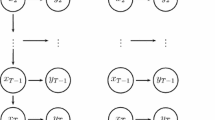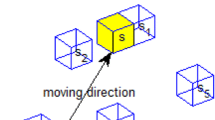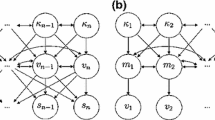Abstract
Geophysical well logs used in petroleum exploration consist of measurements of physical properties (such as radioactivity, density, and acoustic velocity) that are digitally recorded at a fixed interval (typically half a foot) along the length of the exploratory well. The measurements are informative of the unobserved rock type alternations along the well, which is critical for the assessment of petroleum reservoirs. The well log data that are analyzed here are from a North Sea petroleum reservoir where two distinct strata have been identified from large scale seismic data. We apply a hidden Markov chain model to infer properties of the rock type alternations, separately for each stratum. The hidden Markov chain uses Dirichlet prior distributions for the Markov transition probabilities between rock types. The well log measurements, conditional on the unobserved rock types, are modeled using Gaussian distributions. Our analysis provides likelihood estimates of the parameters of the Dirichlet prior and the parameters of the measurement model. For fixed values of the parameter estimates we calculate the posterior distributions for the rock type transition probabilities, given the well log measurement data. We then propagate the model parameter uncertainty into the posterior distributions using resampling from the maximum likelihood model. The resulting distributions can be used to characterize the two reservoir strata and possible differences between them. We believe that our approach to modeling and analysis is novel and well suited to the problem. Our approach has elements in common with empirical Bayes methods in that unspecified parameters are estimated using marginal likelihoods. Additionally, we propagate the parameter uncertainty into the final posterior distributions.
Similar content being viewed by others
references
Avseth, P., 2000, Combining rock physics and sedimentology for seismic reservoir characterization in North Sea turbidite systems: PhD Thesis no. 77, SRB project, Department of Geophysics, Stanford University. Available from http://srb.stanford.edu/Theses/Avseth_:77.pdf
Baum, L. E., Petrie, T., Soules, G., and Weiss, N., 1970, A maximization technique occuring in the statistical analysis of probabilistic functions of Markov chains: Ann. Math. Stat., v. 41, no. 1, p. 164-171.
Bekkevold, J. E., and Bril, A. H., 1998, Analysing and simulating stratigraphic patterns using extended Markov chain analysis: 60th Meeting of the European Association for Geoscience and Engineering, Session 04–39.
Billard, L., and Meshkani, M. R., 1995, Estimation of stationary Markov chains: J. Am. Stat. Assoc., v. 90, no. 429, p. 505-517.
Boggs, S., 2001, Principles of sedimentology and stratigraphy: Prentice-Hall, Upper Saddle River, NJ, 725 p.
Chen, C., and Hiscott, R. N., 1999, Statistical analysis of facies clustering in submarine-fan turbidite successions: J. Sed. Res., v. 69, no. 2, p. 505-517.
Chib, S., 1995, Marginal likelihood from the Gibbs output: J. Am. Stat. Assoc., v. 90, no. 432, p. 1313-1321.
de Gunst, M. C. M., Kunsch, H. R., and Schouten, J. G., 2001, Statistical analysis of ion channel data using hidden Markov models with correlated state-dependent noise and filtering: J. Am. Stat. Assoc., v. 96, no. 455, p. 805-815.
Devijver, V., 1985, On Baum's forward and backward equations: Pattern Recognition Letters, v. 3, no. 6, p. 369-373.
Fredkin, D. R., and Rice, J. A., 2001, Fast evaluation of the likelihood of an HMM: Ion channel currents with filtering and colored noise:: IEEE Trans. Sign. Proc., v. 49, no. 3, p. 625-633.
Godfrey, R., Muir, F., and Rocca, F., 1980, Modeling seismic impedance with Markov chains: Geophysics, v. 45, no. 9, p. 1351-1372.
Harbaugh, J. W., and Bonham-Carter, G., 1970, Computer simulation in geology: Wiley, New York, 575 p.
Krumbein, Y. C., and Dacey, M. F., 1969, Markov chains and embedded Markov chains in geology: Math. Geol., v. 1, no. 1, p. 79-96.
Leonte, D., Nott, D. J., and Dunsmuir, W. T. M., 2003, Smoothing and change point detection for gamma ray count data: Math. Geol., v. 35, no. 2, p. 175-194.
Leroux, B. G., and Puterman, M. L., 1992, Maximum-penalized-likelihood estimation for independent and Markov-dependent mixture models: Biometrics, v. 48, no. 2, p. 545-558.
MacKay, N. C. C., and Peto, L., 1995, Hierarchical Dirichlet modeling in language recognition: Nat. Lang. Model., v. 1, no. 1, p. 450-455.
Malinverno, A., 1997, On the power law size distribution of turbidite beds: Basin Res., v. 9, no. 4, p. 263-274.
Maritz, A., 1989, Empirical Bayes estimation in 2 × 2 tables: Commun. Stat., v. 118, no. 9, p. 3215-3233.
Mavko, G., Mukerji, T., and Dvorkin, J., 1998, The rock physics handbook: Cambridge University Press, New York, 325 p.
Ryden, T., and Titterington, D. M., 1998, Computational Bayesian analysis of hidden Markov models: J. Comput. Graph. Stat., v. 7, no. 2, p. 194-211.
Sharp, W. E., and Markham, T., 1999, A simple chi-square test for determining the absence of Markov cyclicity in sedimentary succesions even when quasi symmetry is present, in Lippard, S., Næss, A., and Sinding-Larsen, R., eds., Proceedings of the 5th Annual Conference of the International Association for Mathematical Geology, no. 2, p. 251-253.
Sinvhal, A., Khattri, K. N., Sinvhal, H., and Awasthi, A. K., 1984, Seismic indicators of stratigraphy: Geophysics, v. 49, no. 8, p. 1196-1212.
Stoffer, D. S., and Wall, K. D., 1991, Bootstrapping state-space models: Gaussian maximum likelihood estimation and the Kalman filter:: J. Am. Stat. Assoc., v. 86, no. 416, p. 1024-1033.
Velzeboer, C. J., 1981, The theoretical seismic reflection response of sedimentary sequences: Geophysics, v. 46, no. 6, p. 843-853.
Weissman, G. S., and Fogg, G. E., 1999, Multi-scale alluvial fan heterogeneity modeled with transition probability geostatistics in a sequence stratigraphic framework: J. Hydrol., v. 226, no. 1–2, p. 48-65.
Yu, J. Z., and Tanner, M. A., 1999, An analytical study of several Markov chain Monte Carlo estimators of the marginal likelihood: J. Comput. Graph. Stat., v. 8, no. 4, p. 839-853.
Author information
Authors and Affiliations
Rights and permissions
About this article
Cite this article
Eidsvik, J., Mukerji, T. & Switzer, P. Estimation of Geological Attributes from a Well Log: An Application of Hidden Markov Chains. Mathematical Geology 36, 379–397 (2004). https://doi.org/10.1023/B:MATG.0000028443.75501.d9
Issue Date:
DOI: https://doi.org/10.1023/B:MATG.0000028443.75501.d9




